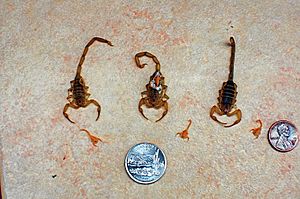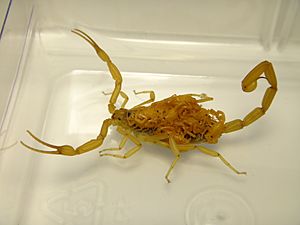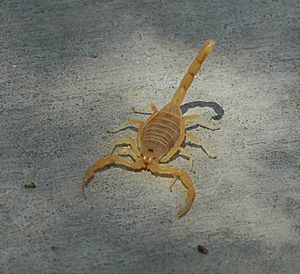Arizona bark scorpion facts for kids
- The striped bark scorpion and the closely related Baja California bark scorpion are also called bark scorpions.
Quick facts for kids Arizona bark scorpion |
|
|---|---|
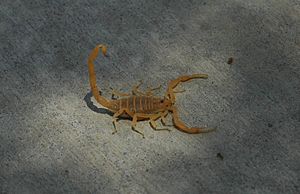 |
|
| Scientific classification |
The Arizona bark scorpion (Centruroides sculpturatus) is a small, light brown scorpion. You can find it in the Sonoran Desert in the southwestern United States and northwestern Mexico. Adult males can grow up to 8 cm (about 3 inches) long. Females are a bit smaller, reaching about 7 cm (about 2.75 inches).
Contents
Life Cycle
Arizona bark scorpions are born live after their mother carries them for several months. The mother gently guides her babies onto her back. A female usually gives birth to 25 to 35 young. They stay with their mother until they shed their skin for the first time, which happens about 3 weeks after birth. These scorpions can live for about 6 years.
Like most scorpions, Arizona bark scorpions are very tough. During nuclear tests in the US, scorpions, along with cockroaches and lizards, were found near the test sites without any harm.
Where They Live
The Arizona bark scorpion is nocturnal, meaning it is active at night. It is very good at living in the desert. Its outer shell, called an exoskeleton, has waxy layers that help it save water. During the hot day, these scorpions hide under rocks, wood piles, or tree bark. They do not dig burrows. They are often found in homes, as they only need a tiny crack (about 1/16 of an inch) to get inside.
These scorpions like areas near rivers or streams that have mesquite, cottonwood, and sycamore trees. These places have enough moisture to support insects and other small animals for them to eat. When people water their lawns or use other systems that make residential areas more humid, it can cause more scorpions to live there.
Centruroides scorpions are special because they are the only type in the Southwest that can climb walls, trees, and other rough surfaces. Arizona bark scorpions like to hang upside down. This is why people often get stung when a scorpion is on the underside of an object they pick up.
What They Eat
The Arizona bark scorpion is a nocturnal predator. This means it hunts at night. It mainly eats insects and other small creatures. Its diet includes:
- Crickets
- Cockroaches
- Spiders
- Centipedes
- Other scorpions
Interestingly, the painful venom of Arizona bark scorpions does not affect grasshopper mice much. Scientists have found that the scorpion's venom actually acts like a pain reliever for these mice!
Who Eats Them
Many animals eat Arizona bark scorpions. These include birds (especially owls), reptiles, and other animals with backbones. Some examples are spiders, snakes, peccaries, rodents, and even other scorpions. Human activities like building new homes, using pesticides, and collecting scorpions for research or as pets can also reduce their numbers.
Venom
The Arizona bark scorpion has the most venomous sting in North America. Its sting can cause severe pain, along with numbness, tingling, and vomiting. These symptoms usually last between 24 and 72 hours. The stung area might not work properly for a while. For example, a hand or arm could become hard to move or have spasms. It might also cause short-term breathing problems. Because the pain is so strong, many people describe feeling like they are getting electric shocks after being stung.
It is very rare for people to die from an Arizona bark scorpion sting, especially with modern medical care. However, thousands of people are stung each year in Arizona.
Antivenom
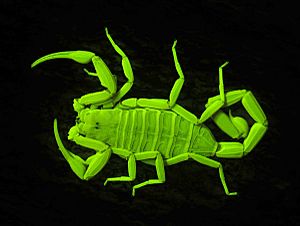
An antivenom (a medicine to treat venom) was created for this scorpion. A Mexican-made antivenom called Anascorp is now approved and used to treat severe stings. It helps to shorten the time people feel sick and need to stay in the hospital.
First Aid
If someone is stung by an Arizona bark scorpion, here are some basic first aid steps:
- Clean the sting area with soap and water.
- Put a cool compress (like a cool, damp cloth) on the sting.
- Take paracetamol or ibuprofen for pain and swelling.
When to Get Medical Help
The amount of venom a scorpion injects can vary. Arizona poison control centers suggest getting immediate medical attention only if the pain is extreme or if a very young child, elderly person, or someone with a weak immune system is stung.
UV Lighting
Arizona bark scorpions, like most scorpions, will glow when you shine a blacklight on them. This is very helpful for finding them because they are active at night. You can easily spot them using a UV LED flashlight from about six feet away. Scorpions that have just shed their skin will not glow under ultraviolet light for a few days.
How to Control and Prevent Them
Arizona bark scorpions are tan or light beige and very small. This makes them hard to see, especially in natural areas with rocks, plants, and different types of soil. They do not usually look for people, but they do look for places to hide. They might sting if they feel threatened or are protecting their young.
People have used several ways to control Arizona bark scorpions:
- Physical barriers: Scorpions cannot climb smooth surfaces.
- Pesticides: Special chemicals can help.
- Glue boards: These sticky traps can catch scorpions.
- Removing hiding spots: Clearing away wood piles, rocks, and other places where scorpions gather near buildings can help.
See also
 In Spanish: Escorpión o alacrán de corteza de Arizona para niños
In Spanish: Escorpión o alacrán de corteza de Arizona para niños


